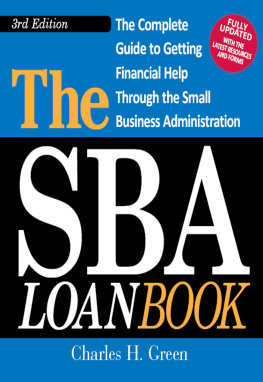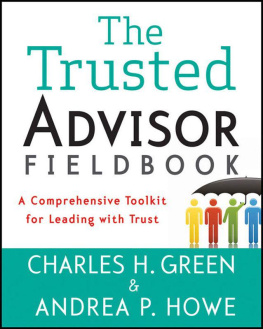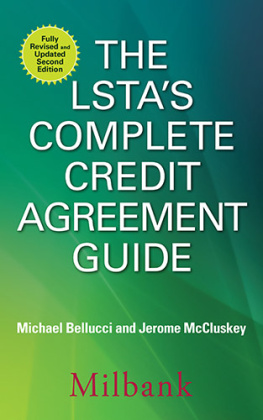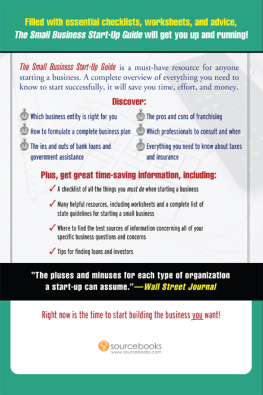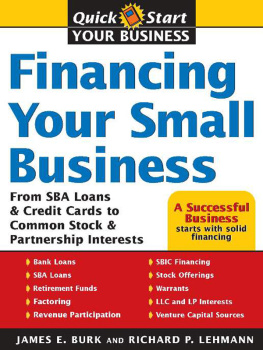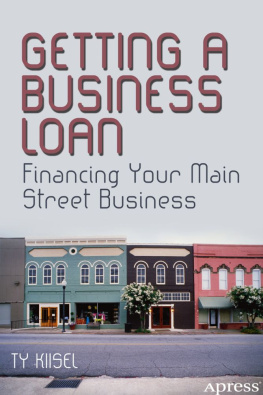The
SBA
LOAN BOOK
3rd Edition
The Complete Guide
to Getting Financial
Help Through the
U.S. Small Business
Administration
Charles H. Green

Copyright 2011, 2005, 1999 by Charles H. Green
Published by Adams Business, an imprint of Adams Media,
a division of F+W Media, Inc.
All rights reserved. This book, or parts thereof,
may not be reproduced in any form without permission
from the publisher; exceptions are made for brief excerpts
used in published reviews.
Published by Adams Media, a division of F+W Media, Inc.
57 Littlefield Street, Avon, MA 02322. U.S.A.
www.adamsmedia.com
ISBN 10: 1-4405-0982-4
ISBN 13: 978-1-4405-0982-7
eISBN 10: 1-4405-1002-4
eISBN 13: 978-1-4405-1002-1
Printed in the United States of America.
10 9 8 7 6 5 4 3 2 1
Library of Congress Cataloging-in-Publication Data
Green, Charles H.
The SBA loan book / Charles H. Green. 3rd ed.
p. cm.
Includes index.
ISBN-13: 978-1-4405-0982-7
ISBN-10: 1-4405-0982-4
ISBN-13: 978-1-4405-1002-1 (ebk)
ISBN-10: (invalid) 1-4405-1002-4 (ebk)
1. United States. Small Business Administration. 2. Small
business United States Finance. 3. Loans United
States Government guaranty. I. Title.
HG4027.7.G74 2010
658.15224 dc22
2010038809
This publication is designed to provide accurate and authori-tative information with regard to the subject matter covered. It is sold with the understanding that the publisher is not engaged in rendering legal, accounting, or other professional advice. If legal advice or other expert assistance is required, the services of a competent professional person should be sought.
From a Declaration of Principles jointly adopted by a
Committee of the American Bar Association and a Committee
of Publishers and Associations
Many of the designations used by manufacturers and sellers to distinguish their product are claimed as trademarks. Where those designations appear in this book and Adams Media was aware of a trademark claim, the designations have been printed with initial capital letters.
This publication is intended to provide current and prospective business owners with useful information that may assist them in preparing for and obtaining an SBA 7(a) or 504 guaranteed business loan. This information is general in nature and is not intended to provide specific advice for any individual or business entity without qualification. While the information contained herein should be helpful to the reader, appropriate financial, accounting, tax, or legal advice should always be sought from a competent professional engaged for any specific situation.
The U.S. Small Business Administration is an agency of the United States government. Every effort has been made to provide accurate and current information as publicly published by the agency. As with any government agency, many regulations, procedures, and programs are constantly under review and revision, and consequently, depending on when the book is read, some information may have changed or been rendered obsolete. The author regrets any errors that may have subsequently been published herein.
This book is available at quantity discounts for bulk purchases.
For information, call 1-800-289-0963.
Contents
Acknowledgments
There are many people I wish to thank that contributed to the production and revision of this book, the third edition. My longtime friend Gene McKay gave me the original idea to take consulting one step further into publication and provided encouragement, advice, and ideas to help make it all happen. My most enthusiastic cheerleader for this latest project has been Stephanie Davis, to whom I am very grateful. Friends and professional acquaintances Jane Butler, Barbara Benson, and Frank Dinsmore provided some clarity in many corners of the broad range of SBA programs to contribute more accuracy to my work.
And I want to remember my dad, Joseph Henry Green (19192005), who taught me how to count money and the value of entrepreneurship.
Introduction
According to recent statistics, more than 99 percent of all business entities in the United States are small businesses. These businesses represent more than 50 percent of the private work force, over 40 percent of all private commercial sales, and in excess of 52 percent of the private-sector output.
Yet obtaining capital financing continues to be a challenge for most small businesses. During the past ten years, financial deregulation changed the landscape with respect to funding available to small businesses. Financing choices became more abundant due to the advent of many new nonregulated lenders and financial products, such as commercial mortgage-backed securities (CMBSs), which were created in the securities market. But conditions quickly changed as these innovative financing vehicles failed to retain investor confidence and actually contributed to the financial market collapse in late 2008.
In a classic case of too much money chasing too few deals, many originating lenders started lowering borrower qualification standards in order to grow business as the nation rebounded financially from 9/11. Finally by early 2008, investors began to question the credit quality and underwriting of these securities and the loans that backed them. Suddenly Wall Street could not fund a robust pipeline of commercial loans because of falling values on the CMBSs already held by the market.
Simultaneously the commercial banking sector was beginning to choke on a variety of problems. The money center banks were finding themselves squeezed by an amassing of unsold loans needing securitization. The economy began teetering on the edge of a liquidity crisis as the market for these securities dried up and the calls for credit default swap (CDS) redemptions went into high gear. Several major investment banks either failed or were forced into a quick sale. The major survivors sought refuge in the commercial banking system, and were granted charters within days of applying. Within ninety days, relatively small discount broker Raymond James became the nations largest independent investment banking shop.
Much of the remainder of the banking industry quickly began choking on a real estate bubble, initially created by the collapse of the home lending market earlier in mid-2007, as sub-prime loan defaults rose sharply and investors began to reject investments in mortgage-backed securities (MBS). As new home construction and home resales fell off sharply in late 2007, the world entered a severe recession that affected virtually every business sector. Most immediate was the ripple effect in the commercial real estate market, which was reeling from rising vacancies, business bankruptcies, and plunging employment figures.
After a few relatively quiet years of a healthy banking sector, banks began to fail in mid-2008. As real estate values began to fall across the United States and bank capital bled, lending to small businesses evaporated almost overnight. The Federal Reserve and the FDIC were almost at open odds about how to address the problem, but meanwhile the economy continued to sink as there was no funding with which to spur growth in the small business sector.
At the time of this revision, it is still unclear as to what the federal government can or will do to restore the financing market for small businesses. In one very positive albeit temporary measure taken in Spring 2009, the federal stimulus program increased the SBA 7(a) guaranty on loans to up to 90 percent (from 75 percent), a move that incentivized banks with capital to make more loans. Additionally, for small business borrowers the guaranty fees on these loans was waived, saving the business up to $56,000. It remains to be seen as to whether that will remain in effect much longer.
Next page
